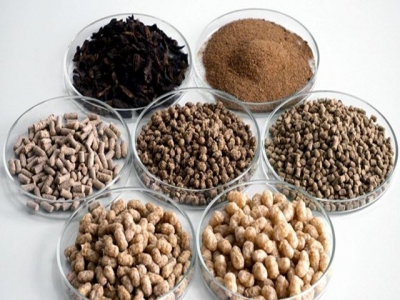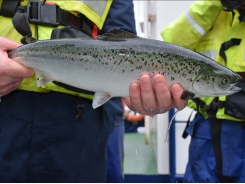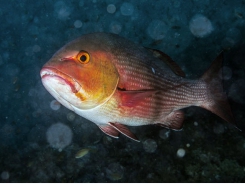Lab-scale testing of novel fish feed ingredients is a growing trend: Brabender

Whether floating, suspended, or slowly sinking, lab-scale extruders enable cost-efficient testing of aqua feed produced from various raw materials such as insect protein, says German firm
German equipment manufacturer, Brabender, has been working with research institutions and aqua feed producers on novel feed formulations for a range of farmed fish and crustacean species in its application lab.
“We have had enquiries from and [carried out] projects with customers mainly from Scandinavia and the US,” Marc Gelautz, marketing manager, Brabender told us.
Whether floating, suspended, or slowly sinking, laboratory extruders make it possible to test aqua feed produced from various raw materials on a reduced scale, added the company.
“Interested parties include fish feed producers, additive manufacturers and research institutes,” said Gelautz.
Brabender showcased its TwinLab-F 20/40 twin-screw laboratory extruder, launched at Aqua Montpellier 2018, at other major aquaculture events this year, including Aquaculture New Orleans 2019 and VICTAM 2019, said Gelautz.
The company is urging more fish feed producers and university-based researchers to visit its customer and technology center in Duisburg to see the capabilities of lab-scale extrusion up-close.
There are several arguments in favor of product development with laboratory extruders such as the TwinLab, said Michael Landers and Julian Foerster, application technicians at the firm’s Duisburg lab.
One is that users can vary their application ideas in a wide variety of ways either in relation to raw materials, formulations, extruder configurations, or products. Users also have the option to establish methods for measuring quality parameters in advance for both the raw material and the final product.
Being 60cm in width, its TwinLab also fits in even the narrowest of laboratories, and it is designed in a way that allows easy access for cleaning and reconfiguration of screws, they told us.
Novel raw material testing
The technicians are convinced that tailored extruded products can solve the problems faced by the aqua feed industry today.
Customized feed is becoming more and more the norm in the aquaculture game, and sustainability drivers are incentivizing industry and academics to test novel raw materials from insects and microalgae to cereal by-products, said Landers.
“It is all about optimizing your product, making the most of raw materials so that there is no waste, and so that the feed is really tailored to the fish species,” he told us.
With new raw materials like insect protein or microalgae, cost is a huge issue though. “Undertaking product development with such raw materials, if you use a large extruder, you will need a lot of raw material, and [chances are] you will waste a lot of it, so it much better to carry out trials with expensive feed ingredients on a small-scale extruder, producing samples that way,” said Landers.
Extrusion challenges
Different process settings are required depending on the feed being produced, the two technicians commented, in an industry note on the benefits of laboratory-scale extrusion.
“For floating feed, including suspended or slowly sinking feed, we operate with hot extrusion at temperatures over 100°C. This results in good pellet expansion. For sinking feed, i.e. production of quickly sinking pellets with minimum expansion, cold extrusion is the preferable method,” wrote Landers.
Feed formulators and academic researchers want to determine which sources of protein are compatible with extrusion, along with the percentage of protein and carbohydrate within those protein sources, they said.
Whether or not a product expands depends on, among other things, the moisture content and the percentage of protein, carbohydrates, and fat in the initial mixture, added the two experts.
“As a product developer, we can determine this precisely in the laboratory. The TwinLab allows us to put various compositions and recipes on the test bench. The degree of expansion can be adjusted and changed with variable process settings. Most important is the optimal cohesion of the constituents to prevent the pellets from disintegrating. The [TwinLab] allows us to test the product characteristics to ensure the recipes are properly adapted to the type of fish and farming method. For example, some species require a high percentage of fat in the feed; however, too much oil delays expansion - we can examine maximum [levels] using the TwinLab. And naturally, the reverse is true, when it is necessary to determine the minimum quantities of ingredients, e.g. for optimization of the sinking characteristics. This can be regulated by adding water, among other things, whereby the pellets are then dried.”
The four upper and two lateral metering openings on the TwinLab also allow liquid or granulated additives such as oils, vitamins, and mineral concentrates or colors to be fed in, said Foerster.
“I’m thinking here of omega-3 fatty acids or carotenes, which are of enormous importance to aquafeed producers and their suppliers.”
Related news
Tools

Phối trộn thức ăn chăn nuôi

Pha dung dịch thủy canh

Định mức cho tôm ăn

Phối trộn phân bón NPK

Xác định tỷ lệ tôm sống

Chuyển đổi đơn vị phân bón

Xác định công suất sục khí

Chuyển đổi đơn vị tôm

Tính diện tích nhà kính

Tính thể tích ao



 Israeli firm’s ‘plug-and-play’ RAS solution attracts investment
Israeli firm’s ‘plug-and-play’ RAS solution attracts investment  Hope for tackling complex gill disease in salmon
Hope for tackling complex gill disease in salmon